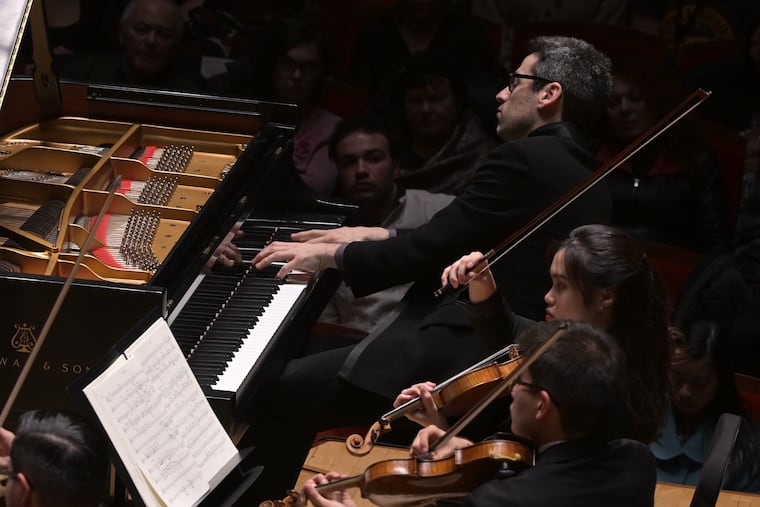Pianist Jonathan Biss performs with Curtis — and then they take Beethoven on the road
The tour schedule for pianist Biss, the Curtis Orchestra, and conductor Osmo Vänskä then hits Bethlehem, Pa. Athens, Ga. Blacksburg, Va.; Durham, N.C., and Carnegie Hall.

Jonathan Biss has cornered the market on Beethoven. That’s not an easy thing to do, especially in this big season marking 250 years since the composer’s birth, but Biss had a running start. He has been recording all of the Beethoven piano sonatas since 2011, and the full nine-disc boxed set is due out in March.
There’s more. Biss will share all the Beethoven piano sonatas with other pianists in an ambitious run of Philadelphia Chamber Music Society recitals over the next few weeks, and Friday night he managed to fit in an “Emperor” Concerto with the Curtis Institute of Music orchestra led by Osmo Vänskä.
They have one foot out the door. After the concert in Verizon Hall, Biss, Vänskä, and the orchestra set off on what the school bills as its first-ever U.S. tour, stopping in Bethlehem, Pa.; Athens, Ga.; Blacksburg, Va.; Durham, N.C.; and Carnegie Hall in New York. (Thursday they performed at Immaculata University.)
Curtis has probably never had a better ambassador for the school than Biss. A Curtis graduate himself, he joined the faculty in 2011. For most of that time, he has been connecting tens of thousands of online learners with Beethoven through a free online course on the piano sonatas. He has the odd gift of being able to completely charm while never alerting his acolytes to the fact that they are getting a first-class education in structural and harmonic analysis.
Tall and wiry, Biss loomed large at the keyboard Friday night in “The Emperor,” Beethoven’s Piano Concerto No. 5. There is a clarity and lack of fussiness in his approach to this piece, which has had its share of overly romantic treatments over the years. He was expressive and heroic, but in all the right places, and not excessively so.
Functioning as a curtain-raiser, Gabriella Smith’s f(x) = sin²x –1/x was an energetic burst. Co-commissioned by Curtis and the Cincinnati Symphony Orchestra, the work is intended as a musical depiction of the mathematical function. We will take her word for it. As an orchestral showpiece, it was effective, presenting itself in colorful melodic shards.
Friday’s concert was originally set to take place in the Merriam Theater. But Verizon is the Curtis orchestra’s traditional venue, and when this reporter asked on Tuesday why the concert was being held at the Merriam, a Curtis spokesperson said Verizon was booked by the Philadelphia Orchestra. Not so, that orchestra said. The Philadelphia Orchestra, it turns out, had given up its hold on the hall more than a year earlier, and by Wednesday, Curtis had decided to switch the concert to Verizon, citing its “superior” sound quality and comfort for the audience.
It actually might have been useful to hear an orchestra in the Merriam, which is smaller than Verizon. But Verizon Hall seemed very much like the right place to hear Sibelius, especially in the way Vänskä conceives of that composer’s particular sound universe.
The encore was Valse triste, and if anyone thought this was intended as just pretty music, Vänskä set the record straight by sculpting a terrifying story of great specificity. This is music composed as incidental music to a play called Death. The creepy quiet of the opening waltz, the reckless speed of the middle material, those three spectral violin chords that end the piece — the conductor heightened the strange qualities of them all.
Vänskä loves contrast. In Sibelius’s Symphony No. 2, he hushed the orchestra to a near-inaudible volume, whipped the sound into a fat frenzy, and deployed generous slices of silence. For those of us who came to this piece by way of Ormandy, who used it to showcase the velvet of his ensemble creation, Vänskä couldn’t be more different. The intensity of the sound and daring of the speed paid off in an interpretation that seemed to portray a specific landscape.
All night, Vänskä’s detailing was apparent — the shape and direction of phrases through connecting certain notes and not others, dynamics finely scaled at certain points and dramatically at others. The conductor, music director of the Minnesota Orchestra through 2022, has an unusually sharp understanding of what makes an orchestra tick. Why is he not directing the orchestral studies program at Curtis?
Moreover, Vänskä’s demands only seemed to instill confidence and even risk-taking within this young ensemble. Flutist Alejandro Lombo and oboist Kip Zimmerman projected not only the skill and talent to be professionals, but also the personal charisma. This was true elsewhere in the orchestra, and that just doesn’t happen unless the players are getting what they need from the podium. Clearly they are.
The Philadelphia Chamber Music Society presents all of the Beethoven piano sonatas played by Louis Lortie (Feb. 11); Llŷr Williams (Feb. 12); Jonathan Biss (Feb. 18, March 19, 24, and 30); and Richard Goode (March 27). Additionally, Mitsuko Uchida performs the Diabelli Variations (April 2). pcmsconcerts.org, 215-569-8080.
Biss continues his online courses in Beethoven with a final installment just released. Information: jonathanbiss.com